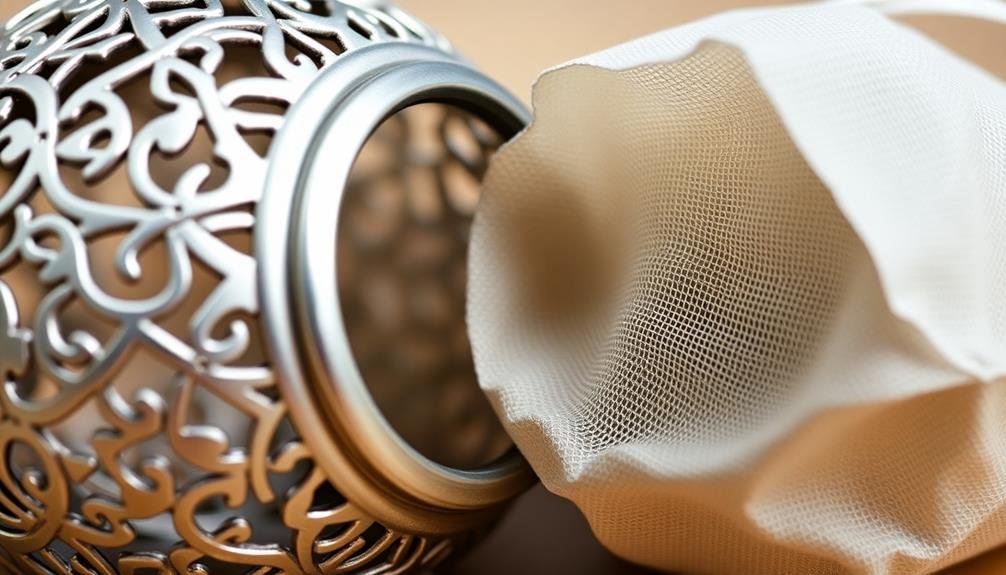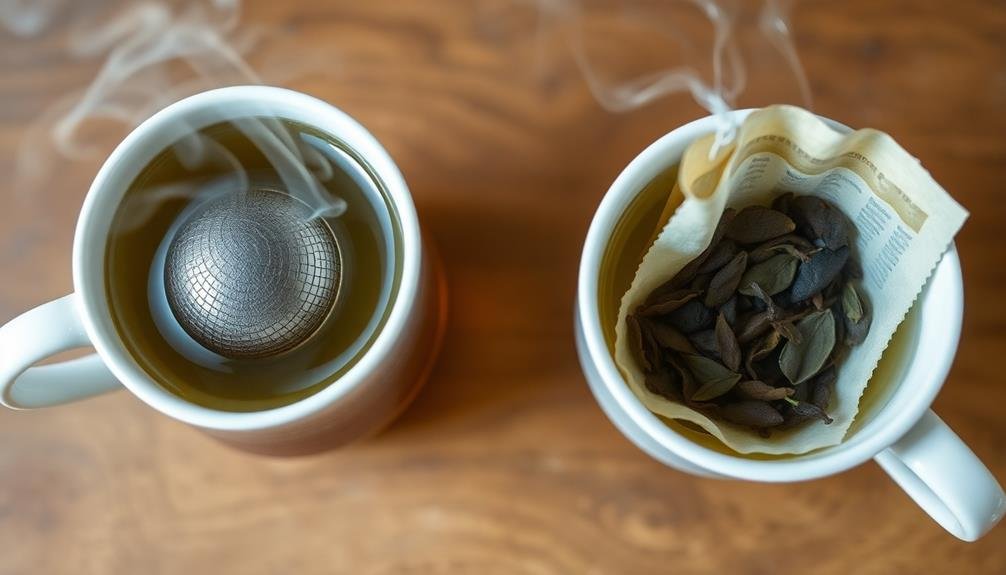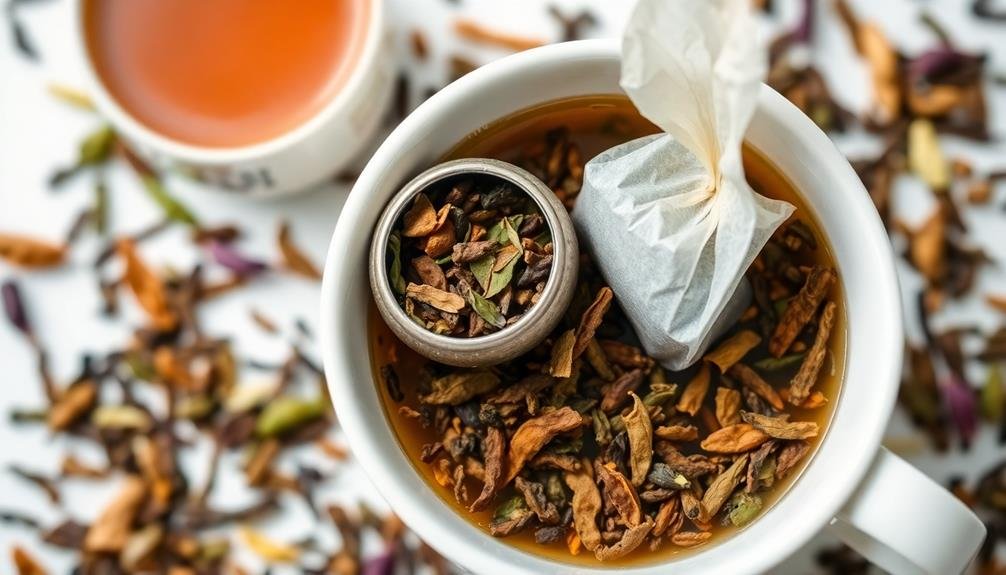Tea balls and tea bags differ notably in five key areas. First, tea balls are reusable metal infusers, while tea bags are typically disposable paper or mesh. Second, tea balls are more sustainable, reducing waste compared to single-use bags. Third, tea balls allow for better flavor infusion as loose leaves have more room to expand. Fourth, tea bags offer greater convenience, being pre-portioned and ready to use. Finally, tea balls provide more versatility, allowing you to explore a wider variety of teas and create custom blends. Understanding these differences can help you choose the best option for your tea-drinking preferences and lifestyle.
Material and Construction

When it comes to material and construction, tea balls and tea bags differ considerably.
Tea balls are typically made of stainless steel or other metals, featuring a mesh or perforated design. They're reusable and come in various shapes, including spheres, eggs, and spoons. You'll find that tea balls have a clasp or hinge mechanism for opening and closing, allowing you to fill them with loose tea leaves.
On the other hand, tea bags are disposable and made from filter paper, silk, or nylon mesh. They're usually square or rectangular, with some brands offering pyramid-shaped bags. Tea bags come pre-filled with tea leaves and are sealed shut, making them convenient for single use.
The construction of tea balls allows for more room for tea leaves to expand, potentially resulting in a fuller flavor.
However, some cheaper tea balls may have larger holes, letting small tea particles escape.
Tea bags are designed to be compact and prevent loose leaves from floating in your cup, but they can sometimes restrict the tea's expansion, potentially affecting the brew's richness.
Reusability and Sustainability
The materials and construction of tea balls and tea bags directly impact their reusability and sustainability. Tea balls are designed for multiple uses, allowing you to refill them with loose tea leaves repeatedly. You can easily clean and dry them between uses, making them a more sustainable option in the long run. By choosing a durable stainless steel or metal tea ball, you'll have a tool that can last for years, reducing waste and the need for frequent replacements.
In contrast, most tea bags are single-use items. Once you've steeped your tea, you'll typically discard the bag and its contents. While some tea bags are compostable, many contain plastic components that don't break down easily. This single-use nature contributes to more waste and a larger environmental footprint. However, some companies now offer reusable cloth tea bags as an eco-friendly alternative.
When considering sustainability, it's important to factor in the packaging as well. Loose tea for tea balls often comes in larger, more efficient containers, while individually wrapped tea bags generate more packaging waste.
Flavor Infusion and Control

While both tea balls and tea bags allow for flavor infusion, they offer different levels of control over the brewing process. Tea balls give you more flexibility in adjusting the strength of your brew. You can easily remove the tea ball from your cup or pot when you've reached your desired flavor intensity. This level of control isn't as readily available with tea bags, which are typically left in the water for a set time.
With a tea ball, you're able to use loose leaf tea, which often results in a more robust and nuanced flavor profile. The larger space in a tea ball allows tea leaves to expand fully, releasing more oils and flavors into your brew.
Tea bags, on the other hand, usually contain smaller, broken tea leaves that may not offer the same depth of flavor.
You can also customize your tea blend in a tea ball by mixing different types of loose leaf teas or adding herbs and spices. This level of experimentation isn't possible with pre-packaged tea bags.
However, tea bags offer consistency and convenience, ensuring a familiar taste with each brew.
Convenience and Portability
Many tea drinkers prioritize convenience and portability when choosing between tea balls and tea bags.
Tea bags generally win in this category, offering a grab-and-go solution that's hard to beat. You'll find them pre-portioned and individually wrapped, making them ideal for travel, work, or quick preparation at home. Just drop a bag in your cup, add hot water, and you're set.
Tea balls require a bit more effort. You'll need to measure loose tea, fill the ball, and clean it after each use. However, they're reusable, which can be a plus if you're environmentally conscious. Some tea balls come with chains or hooks, making them easier to remove from your cup.
If you're always on the move, tea bags are your best bet. They're lightweight, compact, and won't spill in your bag.
Tea balls, while portable, aren't as foolproof. You'll need to carry loose tea separately and might worry about leakage if the ball isn't sealed properly.
Ultimately, your lifestyle will dictate which option suits you best. If convenience is your top priority, tea bags are the clear winner.
Versatility in Tea Selection

Beyond convenience, tea enthusiasts often consider the range of tea options available when choosing between tea balls and tea bags.
Tea balls offer greater versatility in tea selection, allowing you to use any loose-leaf tea you desire. You're not limited to pre-packaged options and can experiment with custom blends, rare teas, or even herbal mixtures.
With tea balls, you can adjust the amount of tea leaves to suit your taste preferences, making stronger or weaker brews as needed. This flexibility extends to mixing different types of teas or adding your own herbs and spices for unique flavor combinations.
Tea bags, while convenient, typically offer a more limited selection of teas. You're generally restricted to what's available in pre-packaged form, which may not include specialty or artisanal teas.
However, some companies now offer a wider range of tea bag options, including whole-leaf teas in larger, pyramid-shaped bags.
If you enjoy exploring diverse tea varieties and creating your own blends, a tea ball provides more freedom. But if you prefer simplicity and don't mind a more limited selection, tea bags might suffice.
Frequently Asked Questions
Are Tea Balls or Tea Bags Better for Loose Leaf Tea?
You'll find tea balls better for loose leaf tea. They allow more room for leaves to expand, resulting in a fuller flavor. You can also control the amount of tea and easily clean them for reuse.
Can Tea Balls Be Used for Cold Brewing?
Yes, you can use tea balls for cold brewing. They're convenient for steeping loose leaf tea in cold water. Simply fill the ball with your favorite tea, submerge it in water, and refrigerate overnight for a revitalizing cold brew.
Do Tea Balls Affect the Caffeine Content of Brewed Tea?
Tea balls don't directly affect caffeine content in your brewed tea. However, they can impact steeping time and water circulation, which may slightly influence caffeine extraction. You'll still get a similar caffeine dose as with loose leaf tea.
Are There Health Concerns Associated With Using Tea Bags?
You might be concerned about potential health risks from tea bags. While they're generally safe, some bags contain microplastics or chemicals. Opt for unbleached, organic options or consider using loose leaf tea to minimize these risks.
How Do Tea Balls and Tea Bags Impact the Overall Cost of Brewing Tea?
You'll find tea balls are more cost-effective in the long run. They're reusable, so you'll save money on disposable bags. However, tea bags offer convenience and portion control, which can help prevent overuse and waste.
In Summary
You've now explored the key differences between tea balls and tea bags. Whether you prioritize sustainability, flavor control, convenience, or versatility, you're equipped to make an informed choice. Remember, there's no universal "best" option – it depends on your personal preferences and lifestyle. Experiment with both methods to discover which suits you best. Ultimately, the perfect cup of tea is the one you enjoy most, regardless of how it's brewed.





Leave a Reply